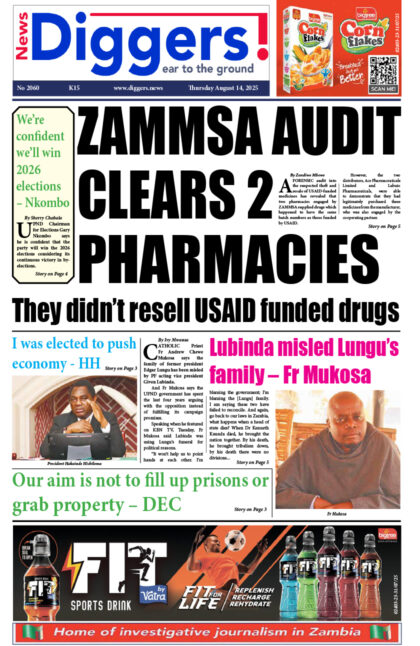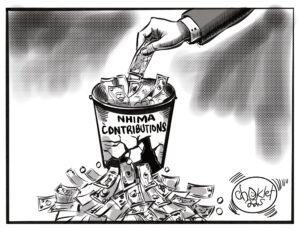International Trade researcher and consultant Trevor Simumba has insisted that the $1.2 billion Lusaka-Ndola dual carriageway project is scandalous and corruption-tainted.
Last month, Simumba said research had revealed that the cost of the said road project was unjustifiably escalated from US $100 million to US $1.2 billion, and that there was no feasibility study conducted on the project.
“I did my research on the Ndola-Lusaka dual carriageway. That road was advertised officially in 2015 by the Road Development Agency (RDA) and it wasn’t the only one; there were about six other roads that were earmarked for Public Private Partnership. And RDA issued RFPs (Actual Requests For Proposals). China Jianxi was nowhere near that tender. The company that won, that was evaluated and came out top was a South African company. A well-known company [but] I won’t mention them because I don’t want to embarrass them, but they were chosen. RDA’s document [show that], you know when you issue an RFP, particularly for roads, you give an estimate of the cost,” Simumba disclosed last month.
“The economic return that was calculated by RDA is 29 per cent, it is there in black and white; I have all the documentation. Currently, what the government is saying is that the economic return is 15 per cent to justify a lengthy concession. So, the question is how are we doing these things because the Minister [of Housing & Infrastructure, Ronald Chitotela] claimed that there is a feasibility study. I went to the Ministry of Housing and Infrastructure, there is no feasibility study, I went to RDA there is no feasibility study. RDA conducted what they call a pre-feasibility. So, give or take, you can increase that $100 million to maybe $200 million because, usually in construction, they have what they call a 25 per cent variance. You can always go above by 25 per cent, but if you start going 100 per cent, 200 per cent that is too much! So, the case study is there. Professor [Oliver] Saasa found that more than 20 per cent of projects that had been allocated, they had cost overruns of over 100 per cent!”
However, in response, RDA director of communications and corporate affairs Masuzyo Ndhlovu said Simumba’s claims were defective and said the US$1.2 billion was the true estimated cost, which could reduce, depending on the scope of works.
“We found that the findings by Trevor Simumba are very defective in that it never tallied with whatever calculations, I don’t know what it was based on and what he was using for those measurements. So, it was difficult to comment even on the percentage he used, the expected economic return and things of that nature that he was bringing up. But again, there were other direct issues you raised like…our area of concentration will be mainly the core road works, which is the 642Km stretch, but, of course, it goes on beyond because there are also by-pass roads. There is a by-pass road in Kabwe, there is a by-pass road in Kapiri Mposhi and then there is also a by-pass road in Luanshya at the Luanshya turn-off; the famous Fisenge-Masangano Road, which is about 45Km. And then the other by-pass road is about 20Km and 20Km. So, when you add [those kilometres], they come to something like 722Km in total in terms of length,” explained Ndhlovu last week.
But reacting to Ndlovu’s response, Simumba stressed that the data used in the research was an extract from the RDA’s own Annual Work Plan for 2018 as well as the Minister’s statement to Parliament, among others.
“I wish to set the record straight. My research was solid and has been validated, including my conclusions on the overall level of Chinese debt to Zambia. The data used in my case study was obtained from the following sources: (a) RDA RFP Programme Title: Public-Private Partnerships for the financing, design, construction to dual carriageway, operation, maintenance and tolling of selected roads in Zambia. RDA/PPP/CE/001/15; (b) Ministerial Statement issued to Parliament on the same project; (c) My case study on the same extracted from my paper on Chinese debt; and (d) Extract from the RDA Annual Work Plan for 2018,” Simumba said in statement issued to News Diggers!, Friday.
He reiterated that the project was scandalous and corruption-tainted.
“This project is scandalous, corruption-tainted project. The RDA must explain properly why it escalated from less than US$ 100 million (K930 million) to over $1.2 billion! The RDA also must explain what happened to the six preferred bidders that were invited under the Restricted Invitation in the above quoted RFP. Was China Jiangxi in that original list of six preferred bidders? If not, how did they become the sole bidder? What were the proposed project costs for the other six bidders? Which engineers conducted the final feasibility study, final engineering designs and the Bill of Quantities that led to this project cost? I believe these are very simple questions to answer, which would help us laymen understand better the justification for this colossal sum. I hope you can direct these queries to the RDA spokesperson and also to the government, including Finance Ministry,” Simumba said.
According to the 2016 RDA’s request for proposals document for Public-Private Partnerships for the Financing, design and construction to dual carriageway, operation, maintenance and tolling of selected roads in Zambia numbered RDA/PPP/CE/001/15, the 321Km stretch of road from Lusaka to Ndola (T002/T003), including 45Km Kafulafuta-Luanshya town (M006), was estimated to have an economic return of approximately 29 per cent.
“Lusaka to Ndola (T002/T003 approximately 321 km, including Kafulafuta to Luanshya Town (M006) approximately 45Km. This road has an economic internal rate of return (EIRR) of approximately 29 per cent and the cost of construction is estimated at K930 million. The implementing authorities are RDA, National Road Fund (NRFA) and the Ministry of Works and Supply,” the document read in part.
And his 2017 statement to Parliament, Housing and Infrastructure Development Minister, Ronald Chitotela, told the House:
“Sir, in June, 2015, the Government of the Republic of Zambia, through the Road Development Agency (RDA), requested the suitably qualified firms to express interest in the implementation of six road projects using the Public Private Partnerships (PPPs). One of the six roads, which was identified is the Lusaka/Ndola Road, and was then earmarked for the expansion to dual carriageway. However, following the completion of the procurement processes for the road in conformity with the laws, MESSRS in Zambia, China Jiangxi Corporation for International Economic and Technical Cooperation (CJIC), was selected as a preferred bidder by the PPPs Council, and subsequently, in December, 2016, the PPPs Council authorised the RDA to engage the selected contractor into the contract negotiations for the project,” Chitotela told Parliament.
“Mr Speaker, in terms of the project details, this august House and nation at large should note that due to the geographical coverage and total number of kilometres to be constructed, the interlinks and the contract sum are as follows: (a) the road, which is part of the regional trunk road network, will cover the key towns of Lusaka, Kabwe, Kapiri Mposhi and Ndola; (b) the total number of kilometres to be constructed comprises approximately 321Km of the core Lusaka to Ndola dual carriageway, and not a single lane, 45Km of the Kafulafuta to Masangano dual road and another 40Km of by-pass roads at Kabwe and Kapiri Mposhi, bringing the total kilometres in single carriageway terms to approximately 812 km; (c) the road has several interlinks, including the Lusaka/Kabwe road − T002 (144 km), Kabwe/Kapiri Mposhi road − T002 (61Km), Kapiri Mposhi/Ndola road − T003 (116Km) and Kafulafuta/Masangano road − M006 (45Km); and (d) the total contract sum is US $1,245,775,986.”
Chitotela had further informed the House that the economic returns to be realised from the project was 15 per cent.
“Mr Speaker, let me give some background. Prior to the signing of the contract, the government engaged professionals to analyse various implementation and financial models of the project as part of the appraisal process. I wish to inform this August House and the Zambian people that the selected financial model has a payback period of seventeen years, with an internal rate of return of 15 per cent. The project under the selected model further shows that the project will generate gross revenues of approximately US $3.5 billion over a period of 17 years after commencement of operations,” said Chitotela.























